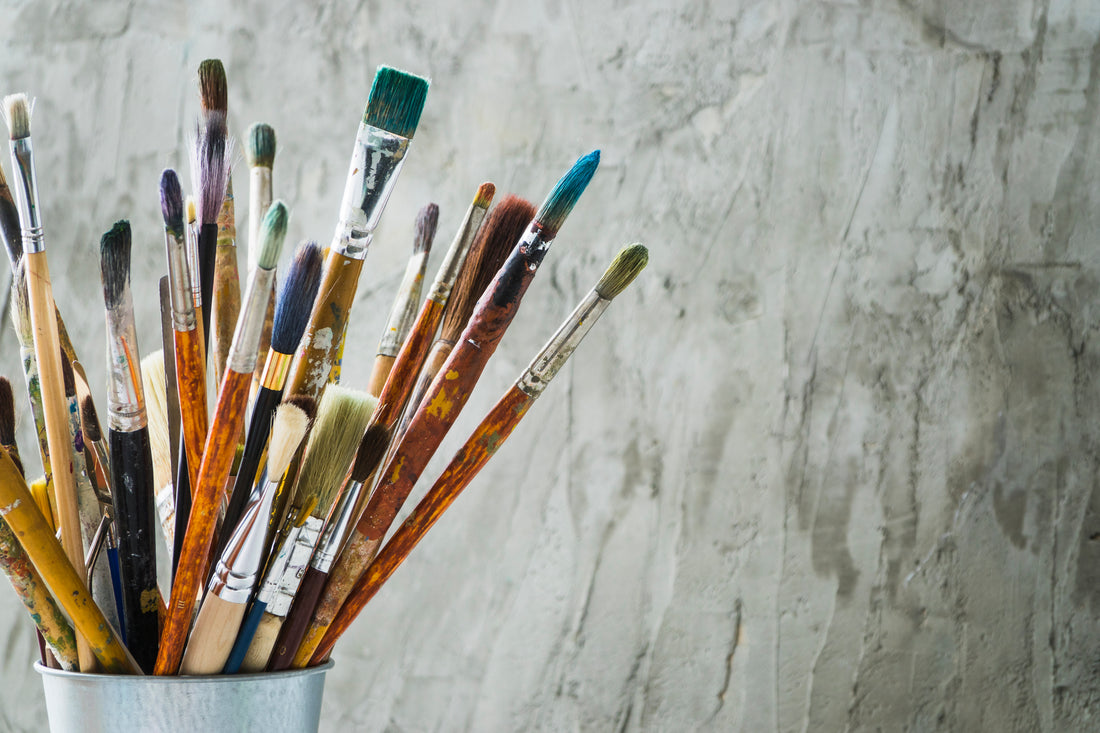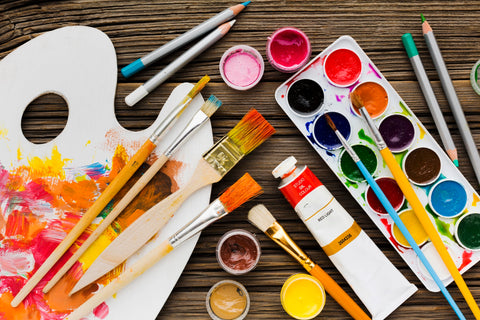
How to Clean and Maintain Your Brushes While Doing a Paint by Numbers Painting
Share
Have you ever taken on a Paint by Numbers project only to find your brushes in a sorry state after just a few uses? Keeping your brushes clean and well-maintained is crucial for achieving beautiful, consistent results in your paintings. In this blog post, we'll delve into the importance of regular cleaning, the materials and techniques needed to keep your brushes in top condition, and additional tips for maintaining their longevity. Say goodbye to dried-up, frayed brushes and hello to a painting experience that's as smooth as your brushstrokes. Let's dive in!
Understanding the Basics: Keeping Your Brushes Clean and Well-Maintained
Keeping your brushes clean and well-maintained is essential for any artist, especially when working on a Paint by Numbers project. Proper brush care not only prolongs their lifespan but also ensures that your paintings are free from unwanted streaks, clumps, or color contamination. In this section, we will explore the basics of brush maintenance, including why regular cleaning is crucial and the materials needed to keep your brushes in pristine condition.
Why Regular Cleaning is Crucial
Regular cleaning of your brushes is vital for several reasons:
-
Paint Removal: Cleaning your brushes thoroughly removes any residual paint, preventing color mixing and contamination. This is particularly important when working on a Paint by Numbers project, where precise colors are essential.
-
Maintaining Brush Shape: When paint dries on the bristles, it can cause them to stiffen and lose their shape. Regular cleaning helps maintain the brush's original form, allowing for more precise and controlled strokes.
-
Preventing Build-up: Over time, paint can accumulate in the ferrule (the metal part that holds the bristles) and cause the bristles to splay or become misshapen. Cleaning prevents this build-up, ensuring that your brushes remain in optimal condition.
Materials Needed for Cleaning
Before diving into the cleaning process, gather the following materials:
-
Water: Clean, lukewarm water is the primary solvent for removing water-based paints from your brushes. It should be at a temperature that is comfortable for your hands.
-
Brush Cleaner: Depending on the type of paint you use (acrylic, oil, or watercolor), you may need a specific brush cleaner. These cleaners are formulated to break down and remove paint effectively.
-
Mild Soap: A mild dish soap or brush soap can be used in combination with water for thorough cleaning. Avoid using harsh detergents or solvents that can damage the bristles.
-
Palette or Plate: You will need a palette or a plate to mix your brush cleaner or soap with water for cleaning your brushes.
-
Lint-Free Cloth or Paper Towels: These are essential for drying your brushes after cleaning and for wiping excess moisture.
Now that you have gathered the necessary materials, let's move on to the step-by-step cleaning procedure in the next section.

How to Clean Your Brushes During a Paint by Numbers Project
Cleaning your brushes during a Paint by Numbers project is crucial to maintain their performance and ensure the integrity of your painting. In this section, we will discuss the step-by-step cleaning procedure, including the importance of regular cleaning, the techniques to remove paint effectively, and the proper care to prevent damage to your brushes.
Why Regular Cleaning is Crucial
Regular cleaning of your brushes during a Paint by Numbers project offers several benefits:
-
Color Accuracy: Cleaning your brushes between color changes ensures that you achieve accurate and vibrant colors. It prevents color mixing and contamination, allowing each section of your painting to be precisely filled with the intended color.
-
Smooth Application: Clean brushes ensure smooth and consistent paint application. Without the buildup of dried paint, your brush strokes will glide effortlessly on the canvas, resulting in a professional finish.
-
Maintaining Brush Performance: By regularly cleaning your brushes, you prevent the paint from drying and hardening on the bristles. This helps maintain the brush's flexibility and shape, allowing for better control and precision in your painting.
Step-by-Step Cleaning Procedure
Follow these steps to clean your brushes effectively and efficiently during your Paint by Numbers project:
-
Prepare your cleaning station: Set up a space with a water container, brush cleaner or mild soap, and a lint-free cloth or paper towels. Make sure you have ample room to work comfortably.
-
Remove excess paint: Before cleaning, remove as much excess paint as possible from your brush by gently wiping it against the edge of your paint palette or a paper towel. Be careful not to press too hard and damage the bristles.
-
Rinse the brush: Dip the brush into a container of clean, lukewarm water. Swirl the brush gently and lightly squeeze the bristles to help loosen any remaining paint. Repeat this process until the water runs clear.
-
Clean with brush cleaner or mild soap: Depending on the type of paint you are using, apply a small amount of brush cleaner or mild soap to your palm or a clean surface. Swirl the brush in the cleaner, working it into the bristles. Gently massage the bristles with your fingers to remove any trapped paint.
-
Rinse and repeat: Rinse the brush under clean water to remove the brush cleaner or soap. Repeat the process if necessary until the water runs clear and all traces of paint are removed. Ensure that no soap residue remains on the bristles.
-
Shape the bristles: After cleaning, reshape the bristles by gently squeezing them with your fingers and forming a point or a flat edge, depending on the type of brush you are using.
-
Dry the brush: Use a lint-free cloth or paper towels to gently blot and remove excess moisture from the bristles. Lay the brush flat or hang it upside down to dry completely before storing or using it again.
By following these steps, you can keep your brushes clean and ready for your next Paint by Numbers session. In the next section, we will explore how to maintain your brushes while painting to ensure their longevity and performance.

How to Maintain Your Brushes While Painting
Maintaining your brushes while painting is essential to ensure their longevity and optimal performance. In this section, we will discuss the signs that indicate your brushes need maintenance, how to choose the right cleaning solutions, and techniques for proper brush maintenance during your Paint by Numbers project.
Signs Your Brushes Need Maintenance
To keep your brushes in good condition, it's important to be aware of the following signs that indicate they need maintenance:
-
Stiff Bristles: If your brush bristles feel stiff or rigid, it may be a sign of dried paint buildup. This can affect the brush's flexibility and make it difficult to achieve smooth brushstrokes.
-
Splayed Bristles: When the bristles of your brush start to splay or lose their shape, it can impact the precision and control you have over your painting. This can be a result of improper storage or rough handling.
-
Frayed or Split Bristles: Frayed or split bristles can lead to uneven paint application and create unwanted texture in your painting. This can occur due to excessive pressure or using the brush on rough surfaces.
If you notice any of these signs, it's important to address them promptly to maintain the quality of your brushes.
Choosing the Right Cleaning Solutions
Selecting the appropriate cleaning solutions for your brushes is crucial to effectively remove paint without causing damage. Consider the following factors when choosing cleaning solutions:
-
Type of Paint: Different types of paint require specific cleaning solutions. For water-based paints like acrylics or watercolors, mild soap and water or a specialized brush cleaner formulated for water-based paints are suitable. For oil-based paints, you may need a solvent such as odorless mineral spirits or turpentine.
-
Brush Material: Some brushes are made from natural bristles (such as hog hair) while others are synthetic. Natural bristle brushes require specific care to avoid damage, while synthetic brushes are generally more resilient. Ensure that your cleaning solution is compatible with the type of bristles you have.
-
Environmentally Friendly Options: If you prefer to use environmentally friendly cleaning solutions, research natural brush cleaners or organic soap options available in the market.
Always follow the manufacturer's recommendations and instructions when selecting cleaning solutions to ensure their compatibility with your brushes.
Techniques for Proper Brush Maintenance
Implement the following techniques to maintain your brushes properly while painting:
-
Frequent Cleaning: Clean your brushes regularly during your Paint by Numbers project, especially when switching colors. This prevents paint from drying and accumulating on the bristles.
-
Gentle Handling: Avoid using excessive pressure or scrubbing motions when painting. Applying too much force can damage the bristles and lead to premature wear.
-
Avoid Submerging Ferrules: When cleaning your brushes, be cautious not to submerge the ferrules (the metal part that holds the bristles) in water or cleaning solution. Excessive moisture can cause the ferrules to loosen and compromise the brush's integrity.
-
Avoid Harsh Chemicals: Refrain from using harsh chemicals or strong solvents when cleaning your brushes, as they can damage the bristles and degrade the brush's performance over time.
By following these techniques, you can ensure that your brushes remain in excellent condition throughout your Paint by Numbers project. In the next section, we will provide additional tips to help you keep your brushes in good shape.

Additional Tips to Keep Your Brushes in Good Condition
In addition to regular cleaning and proper maintenance, there are several additional tips and practices you can implement to keep your brushes in excellent condition. These tips will help prolong their lifespan and ensure optimal performance during your Paint by Numbers project. Let's explore them below:
Inspect Brushes Regularly for Damage
Take the time to inspect your brushes regularly for any signs of damage or wear. This includes checking for loose ferrules, frayed bristles, or any other issues that may affect their performance. If you notice any damage, address it promptly by either repairing the brush or replacing it if necessary.
Proper Brush Storage
Proper storage is crucial to prevent damage to your brushes. Consider the following guidelines:
-
Clean and Dry Brushes: Always clean your brushes thoroughly after each painting session and ensure they are completely dry before storing them. This helps prevent mold or mildew growth and keeps the bristles in good shape.
-
Avoid Crushing or Bending: Store your brushes in a way that avoids crushing or bending the bristles. You can use brush holders, brush rolls, or dedicated brush storage containers to keep the shape of the bristles intact.
-
Separate Different Brush Types: If you have brushes with different bristle types (such as natural and synthetic), store them separately to prevent cross-contamination and potential damage.
Handling & Using Brushes with Care
Handle and use your brushes with care to prevent unnecessary wear and damage. Consider these tips:
-
Avoid Excessive Force: Apply gentle pressure when painting to avoid stressing and damaging the bristles. Let the brush do the work for you.
-
Use the Proper Brush Size: Choose a brush size that is suitable for the area you are painting. Using a brush that is too large or too small can lead to ineffective paint application and potential damage to the brush.
-
Avoid Rough Surfaces: Avoid using your brushes on rough surfaces as it can cause the bristles to fray or break. If you need to paint on a rough surface, consider using a brush with stiffer bristles that are more suitable for such conditions.
By implementing these additional tips, you can ensure that your brushes remain in good condition and deliver consistent results throughout your Paint by Numbers project.
Congratulations! You now have a comprehensive understanding of how to clean and maintain your brushes while doing a Paint by Numbers painting. With proper care, your brushes will continue to serve you well, allowing you to create beautiful artworks with ease. Happy painting!
